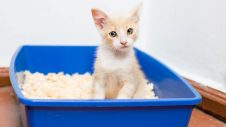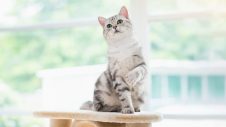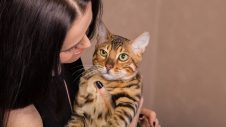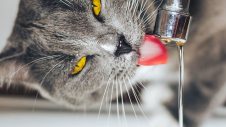Toilet troubles in cats are a reason for concern
Cats are usually more than happy to use their litter box inside or dig in the dirt after a meal or a drink. However, many cats fall victim to feline urinary health or lower urinary tract diseases (FLUTDs), which make it very difficult for them to urinate at all.
While this issue may sound uncomfortable for your cat, difficulty urinating requires immediate veterinary attention. A blockage in the flow of urine is life-threatening, and ‘blocked’ cats can experience kidney damage or even die if not treated within 24 to 48 hours.
There is no single cause of urinary problems, but common symptoms include straining or vocalising when urinating, signs of blood in the urine or urinating in unusual places like the kitchen or bathroom.
Male cats, either neutered or unneutered, are particularly susceptible to urinary tract disorders, as are overweight cats and certain breeds such as Persians.
To help prevent FLUTDs, you can talk to your local Greencross Vet about feeding your cat a quality food low in magnesium, phosphate and calcium to decrease the chances of crystal and stone formation in their urine.
Also, ensure your cat’s litter box is always kept clean and placed in a quiet, secure environment and that your cat gets plenty of exercise.
What is FLUTD?
In the majority of cats with signs of lower urinary tract disease (FLUTD), the cause is unknown. These cats are characterised as having idiopathic lower urinary tract disease or feline idiopathic cystitis (FIC). Stones or uroliths are the next most common condition, with struvite uroliths increasing proportionately to calcium oxalate uroliths in recent years. These conditions are the three most commonly diagnosed lower urinary tract problems in cats.
Risk factors associated with FLUTD
A multimodal approach is recommended for the management of feline urinary tract disease. The approach includes identifying and controlling underlying medical disorders, modifying the cat’s home environment, addressing behaviour issues, and dietary management. Giving an appropriately formulated food is a key element of the complete approach to the long-term management of the most common conditions of FLUTD in cats.
Food
High levels of certain minerals in food can increase the chance of crystal formation. Food also influences the acidity/alkalinity of urine, which can lead to crystal formation. High urine pH can contribute to the production of struvite stones, while low urine pH can produce calcium oxalate stones.
Behaviour
Lack of exercise, confinement indoors, reduced water intake, and even dirty litter trays may cause your cat to urinate less often, leading to the development of FLUTD.
Body Condition
Excess weight also predisposes a cat to FLUTD.
Gender
Urinary obstruction is more common in younger, neutered male cats, but that’s not to say that adult cats and female cats can’t suffer from lower urinary tract disease because they can!
Signs of FLUTD
FLUTD can be uncomfortable and, if a blockage occurs, extremely dangerous. Recognising the typical signs is critical; these include:
- Abnormal urination, including blood in the urine, abnormal colour of urine, excessive straining to urinate, or passing urine frequently in small amounts.
- Abdominal pain.
- Behavioural changes, such as restlessness, listlessness, hiding or refusal to eat.
- Changes in the pattern of urination, such as urinating outside the litter pan or in unusual places.
Male cats, either neutered or unneutered, are particularly susceptible to lower urinary tract disease, as are overweight cats.
Other reasons for house soiling and solutions
House soiling is a common problem that we often encounter with our feline friends. Urinating in odd places can mean either a medical or behavioural problem, and sometimes, the difference is not clear-cut.
Some other reasons for house soiling include:
- Other medical conditions, including urinary tract diseases, colitis, inflammatory bowel disease, diabetes mellitus, hyperthyroidism, and kidney and liver disease, may also cause inappropriate house soiling. These conditions need to be treated by your veterinarian as soon as symptoms are present. Medications and other medical treatments will usually be prescribed.
- Stress and anxiety. Cats use urination and defecation as a means of communication with other cats. It can be a territorial marking, letting other cats know they own the area. Psychological stress, such as the presence of other cats, prolonged absence of an owner, or other problems, may create a need for a cat to reassert a territorial claim. Moving house, changes in routine or an additional member to the family may also cause anxiety for your cat.
Signs that stress may be causing inappropriate house soiling are:
- Spraying on an upright surface.
- Urinating in the litter box sometimes and sometimes elsewhere.
- The cat is not desexed.
- There has been a change at home, leading the cat to feel they must reassert their territorial boundaries.
- The area marked is near a door or window.
- The problem did not start until new furniture was added or the furniture was rearranged.
- The cat appears to be responding to a punishment for another behaviour.
- The cat has marked the owner’s bed or laundry.
- The area marked is the same each time.
Some solutions to feline behavioural house-soiling are:
1. Desexing your cat: hormonal motivations to mark territory are potent and must be removed from the picture.
2. Reducing stressors:
- When moving, keep the cat in a quiet portion of the home when packing and during the actual moving day. When at the new residence, confine the cat in a quiet room and place food, water, litter, and favourite sleeping material in the room. Spend time with the cat in the room and gradually let them become accustomed to the new environment.
- Place numerous litter boxes around the house and use different substrates, e.g. newspaper and litter, until you discover which one the cat prefers. Also, try different depths of litter.
- Clean any soiled areas with enzyme cleaner designed for pet urine and stool (e.g. ‘Urine off’ and Biozet detergent). Regular detergents and other cleaners will not break down the urine or faeces, and if the cat smells any urine or faeces on a carpet or floor, it may continue to use that spot to eliminate. To remove the smell, DO NOT RUB INTO THE CARPET. Simply blot the area with paper towel and then spray with the cleaner. Leave for the instructed amount of time and blot again. A final spray and blot of a vinegar and water solution on the area will remove the smell. Use a blow dryer to dry the patch, and then apply a fine spray of pure alcohol; this makes it unattractive to the cat.
- Use upside-down carpet runners (the ones with the spikes on the bottom), heavy plastic, aluminium foil, double-sided tape, motion detectors, pet repellants or scat mats to limit access to the area where the cat inappropriately eliminates.
- If you catch your cat urinating or defecating outside the box, use a remote correction. This generally means startling the cat (e.g., using a water pistol or whistle), making the cat think it is random and not coming from you. Don’t punish the cat by rubbing their nose in it, as this has no effect on training.
- It may be helpful to confine the cat to a small room with food, water, toys, a bed, and a litter tray so that the cat relearns to use the litter tray. Once this is achieved, you can extend the area they are allowed to be in.
3. Feliway spray or diffuser: these products are pheromone-releasing and can be used in areas of inappropriate soiling. Feline pheromones are naturally deposited when a cat facial marks things, and they have a general calming effect that relieves anxiety.
4. Medication: as a last resort, your vet may prescribe your cat medication to relieve anxiety.
5. Litter box aversion: sometimes, a cat sees its litter box as unacceptable to them. The box may be dirty, not adequately private, smell funny or be uncomfortable. The following are clues to litter box aversion:
- Urination does not involve spraying vertical surfaces.
- Both urination and defecation occur outside the litterbox.
- Two or more cats share a litter box (make sure you have one for each cat PLUS an extra).
- A new brand of litter is being used.
- The box is covered.
- The cat has had a negative experience in the box (i.e. disciplined).
- The litter box is in a heavy household traffic area.
- Other animals are bothering the cat in the litter box.
Tips for getting a cat to use a litter tray:
- Place the cat in there after meals and waking up.
- Make sure it is thoroughly cleaned once a day.
- Place it in a private area away from feeding sites.
- Have a litter tray for each cat plus one extra.
- Try different types of litter in each box until you find out which one the cat likes.
- Use different depths of litter.
If you suspect that your feline friend is having trouble toileting, please contact your local Greencross Vets immediately.

 Greencross Vets
Greencross Vets 










